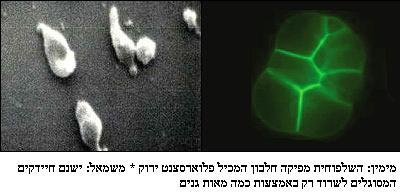An important step towards the production of artificial life
Researchers at Rockefeller University in the US have taken the first principled step towards creating a type of artificial life. They created a synthetic vesicle that produces genes, and resembles a crude type of biological cell.
All the components of what the scientists call "vesicle bioreactors" come from a variety of branches of life. The cell walls were taken from the cells of a hen's egg (more precisely from the protein) while the cell contents are derivatives of the common bacterium E. coli, stripped of its genetic material.
The meaning of life includes ready-made components of the biological machinery needed to produce proteins. The researchers also added to the process an enzyme from a virus that allows the cell to translate DNA code. When genes were added to the process, the cell fluids began to produce proteins, just as a normal cell does.
A gene that causes phosphorescent green color is taken from a species of jellyfish. The cell glowed as a result of the presence of protein and this shows that the genes were indeed copied. Using a second gene, from the bacterium Staphylococcus aureus, the researchers were able to convince their cells to drill pores in the cell walls. This allowed nutrients from the environmental soup to penetrate so that the cell could function in some cases for a few days.
Albert Libchaber, who headed the project, says that the bioreactors are not living creatures - but perform basic chemical reactions that can also be carried out in a biological fluid without cells, but the researchers have nevertheless taken one step forward into a new field known as synthetic biology, whose goal is to redesign an entire organism or create them from scratch.
The entrepreneur Craig Venter, who headed the commercial company that coded the human genome, is now trying to cut down a bacterium to the minimum number of genes necessary for survival. About two years ago, another team showed that polio bacteria could assemble themselves from a mixture of 'off the shelf' chemical ingredients put into a test tube. Some chemists study the type of chemical reactions that led to the creation of life.
Liebchaber's hope is to build a minimal synthetic creature with cell walls and a mix of gene circuits that can survive as a living cell. "As these structures become more and more reminiscent of life, we will have to start rethinking the nature of life. This is a philosophical question, said Dr. Liebschiver. "For me, life is just another kind of machine - a machine with a computer program. No need to add more. However, not everyone shares the same point of view," he said in an interview with the BBC.
He also emphasizes that there is no danger in the experiment. Not only are his cells artificial, but they can only exist in a nutritious environment he provides them. "If you take our system out of its environment, it just won't function." Details from the work of Dr. Liebchiver together with Vincent Noireaux were published in the journal Proceedings of the National Academy of Sciences.

